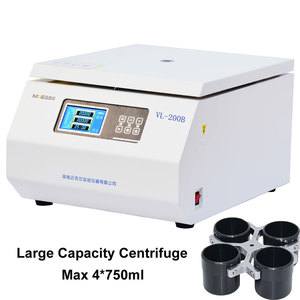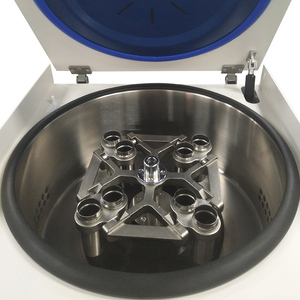
All categories
Featured selections
Trade Assurance
Buyer Central
Help Center
Get the app
Become a supplier

(96 products available)


























Natural rubber latex centrifuge machine processes raw rubber latex into natural rubber by separating the particles. The machine comes in two main types: the eureka machine and the cup-dipping separator.
Eureka machine
The eureka machine centrifuges latex at high speeds. Ridges line its inner cylinder. Operators put the machine on an open-sided platform so that they can access it from the front. The back usually discharges settled dirt or particles. This machine runs rubber latex through a rotating cylinder. Its centrifugal force separates the rubber from contaminants like proteins and lipids. The eureka machine offers a semi-automatic process. Operators must pour the rubber latex into the machine manually. During operation, they must carefully monitor eureka's process to ensure that all contaminants are cleared out. The eureka machine works best for small to medium volumes of rubber latex where a high level of manual control is needed.
Cup-dipping separator
The cup-dipping separator offers a continuous method to separate rubber from contaminants. It works at a consistent speed and processes large amounts of latex. This machine has two parts: the upper cylindrical part collects the rubber, while the lower cylinder is the effluent cup. The separator draws latex into it through the effluent cup. It then spins around to separate the rubber from impurities. The cup-dipping separator works automatically and processes a high capacity of rubber latex in a short time. Operators do not need to monitor it constantly. However, it is not portable like the eureka machine. It is fixed into one position, and its electric source may vary between 220 to 440 volts. The cup-dipping machine is suitable for large-scale production, where a high capacity of rubber latex needs to be processed efficiently and rapidly.
Some machine specifications related to wax latex centrifuge for rubber might be as follows:
Maintaining the performance of a natural rubber latex centrifuge machine is crucial for achieving consistent product quality. Here are some maintenance tips:
The application of a natural rubber latex centrifuge machine extends beyond the production of rubber alone, impacting diverse industries worldwide.
Rubber Harvesting and Processing
Across Southeast Asia, intense centrifuge machines are employed right after rubber trees are tapped. Their main job is to separate the fluid latex into a full-bodied rubber that is ideal for making various products. Without these centrifuge machines, we would have a lot less rubber to work with!
The natural rubber latex centrifuge machine plays a pivotal role in the primary processing of rubberIndustrial Manufacturing
The automotive industry heavily depends on natural rubber. Due to this, there are countless latex centrifuge machines that are essential in separating rubber components for tires, tubes, and other auto parts.
Besides tires, there are also latex centrifuge machines at work in the production of high-performance seals and gaskets. The very same rubber that helps maintain the integrity of automotive systems and ensures they function smoothly. Latex centrifuge machines also help produce intricate rubber components used in electronics, consumer goods, and industrial machinery, such as O-rings, shock absorbers, and insulating sleeves.When purchasing these centrifuge machines for the business, a number of factors have to be considered to ensure the perfect fit for the required area. Ranging from the machine's features to its safety aspects, there is a whole list of things to keep in mind while importing these items for industrial use.
Capacity and dimensions
Most of the time, the capacity is measured in liters or gallons, and the dimensions are shown explicitly in the product specifications. For business use, it's better to go with machines that have a bigger capacity and can hold more gallons of latex. Some smaller machines create an issue in the workload, so it's better to go with something that has more capacity to meet demands.
Working pressure
The business buyers need machines that can handle a high pressure since there is a need to process more raw material on a regular basis. Looking for the working pressure of the machine in bar or psi is important to see if it will be able to fulfill the demands of the industry or not.
Control and automation
When looking into centrifuge machines for business, it's better to buy those with automatic features since they are easier to operate and have more safety features. The control system should be user-centered and intuitive so that the workers can easily understand how to use it without any sort of training.
Material and durability
A centrifuge machine has to be durable and long-lasting to work for industrial use. The material has to be matched with industrial needs, so it's better to go with stainless steel since it is corrosion-resistant and can withstand latex as a substance.
Maintenance
It is better to consider the maintenance requirements before importing a large number of machines. The machines should have easily replaceable and maintainable parts, and the instructions regarding the maintenance process should come with the device so that it doesn't get damaged.
Transportation
Are the needs of transport met? Are the shipping costs reasonable? Can the delivery time be calculated? These things become important when buying latex rubber centrifuge machines in bulk. Since customs will treat it as a commercial import, everything regarding transportation should be looked into properly so that there are no extra costs to bear at the end of the journey.
Technical support
When investing in such items, it's always better to go with a retailer who offers technical support and can guide during the installation process of these items at the warehouse. A locally available after-sales service is essential in case of an issue some time down the road.
Q1: What are the four main items found in the rubber latex separation process using centrifuge machines?
A1: Centrifuge machines will separate these four main items in the natural rubber latex processing plantation. They are concentrated rubber latex, rubber serum or watery solution, clumps of coagulated rubber, and settle solids or sediment.
Q2: What are the five main steps of the centrifuge process of rubber latex?
A2: The centrifuge machine helps to quicken the rubber latex separation process. The five main steps are input of feed, spinning, separation, extraction, and discharge. Some centrifuge machines may have an additional filtration step in between spinning and separation.
Q3: Does the centrifuge machine's speed affect the separation efficiency of natural rubber latex?
A3: Yes, it does. Higher centrifuge speeds can improve separation efficiency by generating greater centrifugal forces.
Q4: What are the two most popular types of centrifuge machines used to separate liquid from solid in the natural rubber processing?
A4: The continuous flow disc-stack centrifuge and the horizontal screen centrifuge are two popular types of centrifuge machines that can process large volumes of liquid simultaneously.